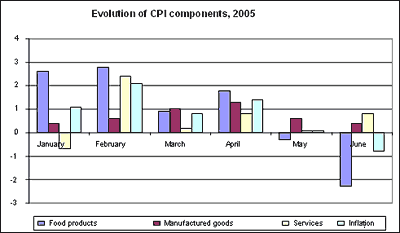| About us |  |






| Elections |  |






| Civil Society |  |




| Points of view |  |





| Useful information |  |



|  |
Socioeconomic Commentaries

Foreseeing for inflation: optimism of authorities will "face" the bitter reality
Iurie Gotisan, July 11, 2005
The consumer price index (CPI) dropped by 0.8 percent in June, compared with May 2005, mainly due to the season decline of prices of food products. We said in a previous commentary that significant declines of prices of food products, as well as deflation are registered at summer. Inflation in June validated our forecasts and a deflation was registered for the first time this year. A 4.7 percent cumulative annual inflation rate was recorded in the first half of this year.
However, the optimistic estimates of the Government and National Bank of Moldova for this year indicate a 8-10 percent inflation rate. In addition, officials of the International Monetary Fund said, while on a working mission to Moldova two weeks ago, that the National Bank will succeed to maintain the inflation at nine percent and even at a lower level. However, I have some reservations over optimism of authorities and forecasts of IMF high ranking officials. I will explain further on why inflation this year will not probably fit the limits forecasted by authorities, of course, if they do not falsify the official figures.
The forecasted inflation could be "overturned" under incidence of several factors, including:
- permanently bad situation (registered in the latest period) of agriculture sector, whose negative productive results (in many branches of this sector) were observed in higher prices, particularly of food products (namely the CPI for food products rose the most in January-May 2005);
- growth of production costs (salaries, acquisition of raw material, etc.) in the industrial sector. In addition, many domestic enterprises which are dependent on imported raw materials had to pay higher prices for them;
- higher consumption demand financed both from internal sources (salary rise, reduction of taxes, etc.), and external sources (massive currency remittances from abroad);
- influence of administrative factors such as growth of some tariffs for public services, public transportation, etc.
- high prices of imported oil products due to their global rise (importers of fuels are tempted again to review the prices posted by filling stations);
- potential rise of natural gas prices supplied by Russian concern Gazprom and their supply to enterprises and dwelling sector for much higher tariffs (recently Russia's State Duma has unanimously approved an appeal to the cabinet of ministers, in which it seeks higher tariffs for natural gas supplied to some states in the CIS and the Baltics, including Moldova).
I do not see a lower inflation than 10 percent for late 2005, if taking into account these figures and factors. Although the internal context envisages the economic growth and the economic environment is positive in general, there are high risks for 2005, which especially come from the foreign deficit (trade and current account deficit) and inflation area.
The appreciation of leu vs main reference currencies is preferable from macroeconomic point of view under pressure of speculations on exchange rate. The curve of prices presents two inflationary jumps this year, mainly generated by rise of prices of energy agents (electricity, natural gas), and oil products (gasoline, Diesel oil, etc.). The first monthly peak of inflation was registered in April-May, and we will "experience" the second one at the end of this year, in November-December.
Many persons could wonder: how can the government, for example, keep the inflation within established limits on one hand, and increase the prices of energy agents on the other hand? It is hard enough, isn't it? Yes, it is a big provocation, but we should probably regard the general economic situation in Moldova. Reduction of income tax and corporate profit tax, rise of salaries for several categories of workers, as well as growth of pensions starting April 1, 2005 brought and will bring additional money to people. This would help them, at least partially, to bear potential higher energy prices more easily.
Dangers for the 10-percent annual inflation target do not come only from potential rises of natural gas and electricity prices. Being part of many consumer prices, the price of fuels is also a serious threat. As a general rule, higher prices of fuels (oil products, natural gas) will create economic and psychological premises needed for rise of prices of most of food products and manufactured goods.

Source: the National Bureau for Statistics (BNS)
|
 |





|